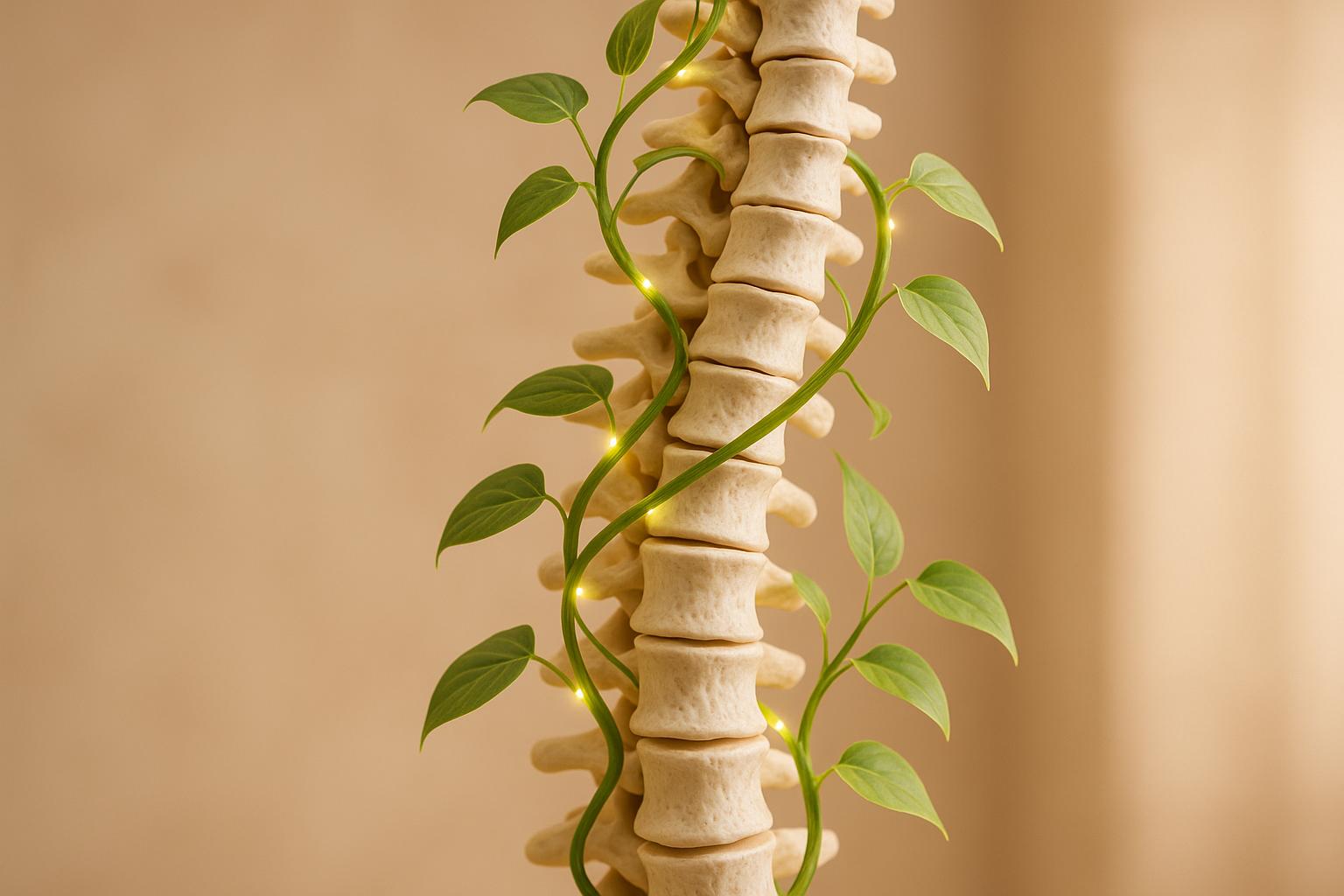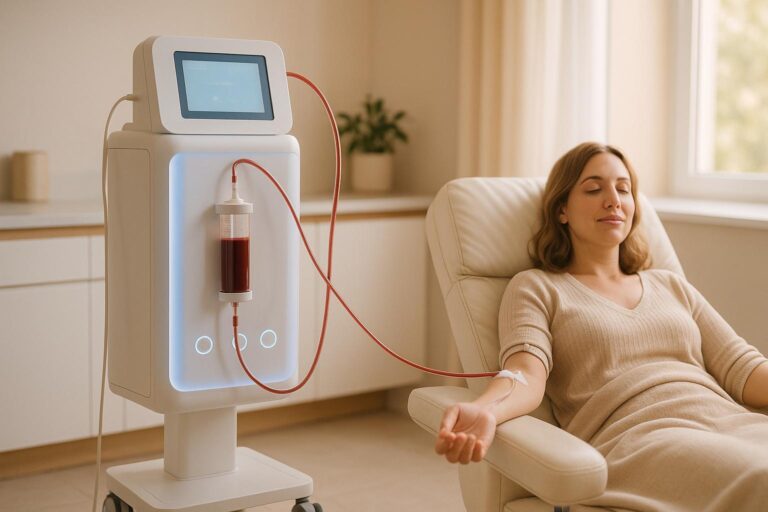Your gut and spine are more linked than you might think. Recent research highlights how the balance of bacteria in your gut – known as the gut microbiome – can influence spinal health, pain, and even degenerative conditions. This connection, called the gut-spine axis, shows that gut health impacts inflammation, bone strength, and recovery from spinal injuries. Here’s what you need to know:
- Gut microbiome and inflammation: An imbalanced gut can release inflammatory compounds that harm spinal structures like bones and discs.
- Key pathways: The gut communicates with the spine through immune, hormonal, and neural signals, affecting pain perception and spinal function.
- Probiotic potential: Certain probiotics, like Lactobacillus and Bifidobacterium, may help reduce inflammation and support spinal recovery.
- Practical steps: Improve gut health with fiber-rich foods, fermented products, hydration, and stress management.
This emerging research suggests that addressing gut health may be a new way to manage spinal conditions, alongside traditional care.
Gut Inflammation & Lower Back Pain: The Missing Link
How Your Gut Affects Spinal Health
The link between your gut and spine is more than just an interesting concept – recent discoveries show how intricate this connection truly is. The gut-spine axis highlights pathways that can either support or undermine spinal health, depending on how well-balanced your gut microbiome is.
The Science Behind Gut-Spine Communication
Researchers have uncovered how the gut microbiome communicates with the spine through immune, hormonal, and neural pathways. These pathways enable gut bacteria to influence spinal health in ways that extend far beyond digestion.
"Mechanistically there are three general ways in which the gut microbiota and host can communicate to regulate metabolism and digestion: immunological, hormonal, and neuronal." – Tyler M Cook, Virginie Mansuy-Aubert
Here’s how it works: signals from gut microbes are relayed via vagal and spinal neurons, processed by the brainstem and hypothalamus, and then transmitted to the spine. Enterochromaffin cells in the gut produce around 90% of the body’s serotonin, a neurotransmitter essential for pain perception and spinal function. Meanwhile, beneficial bacteria like Lactobacillus and Bifidobacterium produce gamma-aminobutyric acid (GABA), which calms spinal neurons by reducing their excitability. Gut bacteria also ferment dietary fiber into short-chain fatty acids (SCFAs), which help regulate inflammation and energy balance, indirectly benefiting spinal health.
| Signaling Molecule | Mechanism of Action | Effect on Nervous System |
|---|---|---|
| Serotonin (5‑HT) | Activates 5‑HT receptors | Supports enteric neuron development, maturation, and ongoing function |
| GABA | Activates GABAB receptors | Lowers spinal neuron excitability and reduces sensitivity to mechanical stimuli |
| Short-chain fatty acids (SCFAs) | Activates FFAR3 receptors | Affects energy expenditure, food intake, and gut metabolism |
| Lipopolysaccharide (LPS) | Activates TLR4 receptors | Impacts gut motility, immunity, and nervous system development |
When the gut microbiome is in balance, these mechanisms work together to support spinal health. But when this balance is disrupted, problems arise.
When Gut Bacteria Go Wrong: Impact on Your Spine
An imbalanced gut microbiome – known as dysbiosis – can have serious consequences for your spine. Dysbiosis has been linked to accelerated intervertebral disc degeneration through changes in immune response, bacterial translocation, and altered metabolite production.
For example, a study conducted at Rush University Medical Center, published on October 10, 2024, analyzed 33 patients with lumbar degenerative spondylolisthesis. It found that these individuals had a different gut microbiome composition compared to healthy participants. They showed a higher Firmicutes-to-Bacteroidota ratio, increased levels of pro-inflammatory bacteria like Dialister and CAG-352, and reduced levels of anti-inflammatory bacteria such as Slackia and Escherichia-Shigella.
Dysbiosis also weakens the intestinal barrier, allowing harmful bacteria and inflammatory compounds to infiltrate spinal tissues. Metabolites from an imbalanced gut – like SCFAs produced under dysbiotic conditions – can penetrate disc tissues, contributing to calcification and degeneration. Additionally, lipopolysaccharide (LPS) promotes low-grade systemic inflammation, which further impacts spinal health.
Animal studies using spinal cord injury models have highlighted these effects even more. Researchers observed significant increases in pro-inflammatory bacteria such as Shigella, Bacteroides, and Staphylococcus, along with decreases in beneficial bacteria like Lactobacillus and Sutterella. This shift toward harmful bacteria triggers inflammation, potentially worsening spinal conditions and slowing recovery.
Probiotics for Spinal Health: Research Findings
Recent studies in animal models suggest that probiotics could play a role in restoring gut balance and aiding spinal recovery. By exploring the connection between the gut and spine, researchers are uncovering how targeted probiotic treatments might improve spinal stability and promote healing. Here’s a closer look at what the research reveals.
What Studies Show About Probiotics and Spine Health
In one study using a mouse model of spinal cord injury (SCI), continuous administration of the probiotic VSL#3 after injury led to several positive outcomes. These included improved immune markers, enhanced motor recovery, and reduced neuropathology. By three weeks post-injury, the mice showed a 30% drop in Bacteroidales and a 250% increase in Clostridiales. The treatment also boosted levels of CD4⁺CD25⁺FoxP3⁺ regulatory T cells in mesenteric lymph nodes, which helped control inflammation and support tissue repair.
Another study focused on mice with gut dysfunction and found that the probiotic strain B. lactis A6 had significant benefits. It improved body weight, limb strength, and exercise capacity while reducing muscle damage. The intervention also helped minimize muscle mass loss, suppressed markers of muscle atrophy, and enhanced bone density and structure. Key improvements were observed in bone mineral density (BMD), bone volume fraction (BV/TV), trabecular thickness (Tb. Th), and trabecular number (Tb. N). These findings are especially relevant, as more than one-third of individuals with inflammatory bowel disease (IBD) experience muscle and bone loss, increasing their risk of falls, fractures, and other complications.
Which Probiotic Strains Help Your Spine
Research has pinpointed certain probiotic strains that may directly benefit spinal health. Strains from the Lactobacillus and Bifidobacterium genera show particular promise. VSL#3, a well-studied multi-strain formulation, has been shown to produce metabolites like butyrate, other short-chain fatty acids, and neurotransmitters. These compounds help regulate inflammation and immune function, which can positively impact spinal health.
The B. lactis A6 strain stands out for its ability to strengthen the gut’s mucosal barrier and increase butyrate production. These effects not only provide anti-inflammatory benefits but also improve bone density. Additionally, probiotics containing these strains have been linked to enhanced regulatory T cell activity in animal models of multiple sclerosis, suggesting potential benefits for other neurological conditions that affect the spine.
While these findings are promising, it’s important to note that much of the current research is based on animal studies. Human clinical trials focusing specifically on spinal health are still limited. Future research will need to address optimal dosing, treatment duration, and the effectiveness of specific probiotic strains for various spinal conditions. Even so, these studies highlight the potential of gut health as a factor in managing spinal disorders and lay the groundwork for further exploration in this area.
sbb-itb-d9e542d
How to Support Your Gut and Spine Health
Taking care of your gut and spine requires thoughtful dietary choices, targeted supplements, and specialized care. New research highlights the connection between the gut and spine, showing how your diet and microbiome support can directly affect your overall health.
Diet and Probiotic Recommendations
The foundation of gut and spine health begins with what you eat. Columbia gastroenterologist Daniel Freedberg, MD, emphasizes the importance of dietary fiber:
"Dietary fiber is a prebiotic – it changes which bacteria are present in the gut. Fiber is inexpensive and natural, and by changing your dietary fiber intake you are changing your gut bacteria".
To nurture your gut, include prebiotic-rich foods like garlic, onions, leeks, asparagus, bananas, and artichokes in your meals. These foods help feed the good bacteria in your gut, allowing them to thrive. Combine these with fermented foods like yogurt, kefir, sauerkraut, and kimchi to introduce beneficial probiotics directly into your system.
Other simple habits can also make a big difference. Drink plenty of water (a squeeze of lemon can boost enzymes), aim for 30 minutes of daily exercise to improve gut motility, and practice stress-management techniques like meditation or yoga.
For additional support, consider supplements such as probiotics, digestive enzymes, and gut-healing nutrients like glutamine and collagen. If you suspect food intolerances are disrupting your gut health, consult a healthcare provider to identify and eliminate potential triggers. Cutting back on processed and sugary foods, refined carbs, fried and fatty options, red and processed meats, and excessive alcohol can also help reduce inflammation and discourage the growth of harmful bacteria.
Personalized Care at Kinnection Clinic

While dietary changes set the stage, personalized clinical care can take your gut and spine health to the next level. At Kinnection Clinic, tailored interventions address specific imbalances, strengthening the connection between your gut and spine. Functional medicine principles guide their approach:
"Traditional medicine focuses on treating symptoms, while functional medicine offers a proactive, preventive, and personalized approach that prioritizes optimizing overall health and longevity".
Using advanced diagnostics, the clinic identifies imbalances in your gut microbiome and spinal alignment. Treatment plans, including customized probiotic formulations, are designed to restore balance, improve nutrient absorption, and reduce inflammation.
Kinnection Clinic also integrates Gonstead chiropractic care with functional medicine to address both spinal alignment and gut health. This combined approach acknowledges the gut’s role in digestion, immunity, and mental clarity, all of which can impact spinal well-being. Dr. Lars Gunnar and his team create personalized plans that may include nutritional advice, targeted supplements, and spinal care tailored to your needs. By focusing on root causes rather than just symptoms, their approach aims for lasting improvements in both gut and spine health.
The Future of Gut-Spine Research and Treatment
The growing field of gut-spine health is opening doors to new spinal treatments. As scientists uncover more about the relationship between the microbiome and the spine, the potential for personalized therapies becomes increasingly clear. These discoveries are shaping how we approach spinal health and treatment.
Key Points to Consider
The connection between the gut and spine is reshaping our understanding of spinal health. Research now highlights how the gut microbiome influences not just digestion but also the central nervous system. This is particularly relevant given that nearly 20% of American adults face mental health challenges.
The microbiome’s unique composition and genetic diversity extend its impact far beyond the gut. These findings have practical implications too. For example, lumbar spinal fusion costs Medicare over $33 billion annually, emphasizing the need for alternative treatments. On the nutritional side, more than half of Americans consume less magnesium than the recommended amount, suggesting that even simple dietary changes might improve spinal health.
What’s Next for Gut-Spine Research
Future research is focused on developing more precise, microbiome-targeted therapies. These go beyond traditional probiotics to include innovative approaches like fecal microbiota transplantation (FMT), targeted magnesium supplementation, and customized probiotic blends aimed at improving spinal health and recovery.
Advances in synthetic biology are also paving the way for groundbreaking treatments. Scientists are engineering bacteria with therapeutic properties, moving past single-strain probiotics to create microbial consortia that work together to restore diverse and stable gut communities.
Short-chain fatty acids (SCFAs) are emerging as key players in this field. These molecules help regulate immune responses and maintain the integrity of the gut and blood-brain barriers. Christoph Thaiss, PhD, from Stanford Medicine, explains:
"These molecules are extremely important for the brain to make sense of what’s going on inside the body and then regulate physiological states accordingly".
Regulatory frameworks are also adapting. Live biotherapeutic products (LBPs) are now classified as pharmaceuticals and are subject to FDA and EMA oversight to ensure their safety and effectiveness, marking a shift from how traditional probiotics are regulated.
Personalized medicine is becoming a reality as researchers integrate patient and microbiome data. Efforts are underway to standardize the collection, sequencing, and analysis of this data, improving consistency across medical centers and reducing interpretation biases. This approach will help clinicians predict how individual patients might respond to dietary or microbial interventions by identifying specific relationships between dietary compounds and bacterial strains.
The microbiome has been referred to as "the next frontier of personalized medicine". Unlike genetics, which has a limited role in shaping the microbiome, targeted changes to the microbiome can be made across individuals from diverse genetic backgrounds. This means gut-spine therapies could benefit a wide range of patients, regardless of their genetic predispositions.
Looking ahead, the integration of chiropractic care, functional medicine, and microbiome science holds promise for creating comprehensive, root-cause treatments. These advancements could soon become the foundation for personalized treatment plans that address spinal health more effectively.
FAQs
How does gut health impact spinal health and pain management?
The gut microbiome plays an essential role in spinal health and pain management, thanks to its connection to the gut-brain axis. This complex system impacts inflammation, immune responses, and even how the body processes pain. When the gut microbiome becomes imbalanced, it can lead to chronic inflammation, which may worsen spinal discomfort and other musculoskeletal problems.
Probiotics might offer some relief by creating a healthier gut environment, helping to reduce inflammation throughout the body, and supporting spinal well-being. By restoring balance in the gut, they can contribute to pain management and overall health. A healthy gut and a well-supported spine often work together to promote long-term wellness.
What dietary changes or supplements can support both gut and spine health?
To support both gut and spine health, it’s important to focus on a well-rounded diet filled with nutrients like calcium, vitamin D, magnesium, omega-3 fatty acids, and antioxidants. You can get these from foods such as green leafy vegetables, fatty fish, dairy products, nuts, and seeds. Adding lean proteins like chicken or turkey to your meals can also be helpful.
In addition to dietary choices, certain supplements might play a role in promoting gut and spinal well-being. Options like probiotics, glutamine, and collagen can assist by improving nutrient absorption, calming inflammation, and supporting the health of connective tissues. However, before introducing any new supplements, it’s wise to consult a healthcare professional to ensure they’re a good fit for your individual health goals.
What probiotic strains can help with spinal recovery, and how do they work?
Certain probiotic strains, like Lactobacillus rhamnosus GR-1 and VSL#3, might play a role in supporting spinal recovery by helping to reduce inflammation in the body. These probiotics work by balancing gut bacteria, which can impact the gut-spine connection and contribute to better spinal health.
By promoting a healthier gut, these strains may improve nutrient absorption and help lower systemic inflammation – both critical factors in spinal healing and recovery. Be sure to consult a healthcare provider to find the best option for your individual needs.



